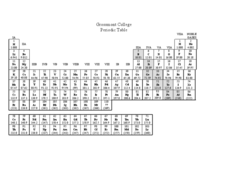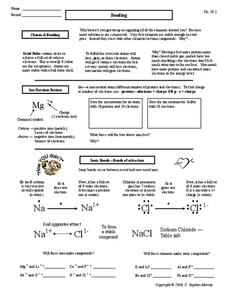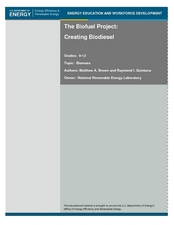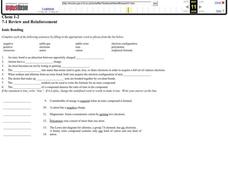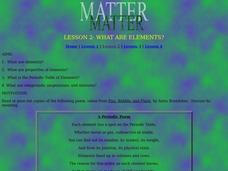Curated OER
Chemicals, Chemicals, Everywhere
Students divide substances into categories: made of chemicals/not made of chemicals, synthetic/naturally occurring, and toxic/nontoxic. They observe a mystery chemical and determine what precautions they need to take when handling an...
Curated OER
More Chemical Bonding
In this chemical bonding activity, students review the three types of compounds: ionic, covalent, and polyatomic. Students practice drawing the covalent bonds of given compounds. This activity has 5 drawings and 13 fill in the blank...
Curated OER
Alkane Nomenclature Worksheet
This worksheet asks learners to work on alkane nomenclature. They name 2 straight-chain alkanes and answer 4 questions about branched-chain alkanes. In addition, class members name 5 branched-chain alkanes and draw the structures for 3...
Curated OER
Chemical Bonding and Shapes of Molecules
In this chemical bonds worksheet, students review the different types of bonds, Lewis dot structures, ions, and molecule shapes. This worksheet has 10 matching, 17 multiple choice, and 3 drawing questions.
Curated OER
Organic Chemistry Practice Test
Framed as an organic chemistry practice test, this resource could be used for a variety of purposes. Composed of 15 questions about organic compounds such as isomers, alkynes, alkenes and amines, and other topics related to organic...
Curated OER
Bonding Basics Practice Page
In this chemistry worksheet, students complete each of the bonds listed. They draw the Lewis structures for each atom and show the transfer of electrons and charge for each ion. Students also draw the Lewis structures for each atom and...
Curated OER
Chemistry 116 Exam 2 Summer 2009
Written for an introductory organic and biochemistry course, this exam will challenge your class. They label functional groups and stereocenters on drawings of molecules, draw structures given the name, complete drawings of chemical...
Curated OER
Bonding
In this bonding activity, students read about the two different types of chemical bonding: ionic and covalent bonds. Students review ion notation and oxidation numbers. This activity has 24 fill in the blank, 2 drawings, and 4 short...
Curated OER
Catering Middle-School Science: Monomers, Polymers, and Macromolecules
Students investigate foods. In this biology lesson plan, students will conduct testing on different types of foods as they learn about different molecules that make them up. Students will also learn about the shapes of the molecules.
Curated OER
The Bio-fuel Project: Creating Bio-diesel
Students investigate bio-fuel. In this investigative lesson, students create bio-fuel from vegetable oil waste. Students will analyze, predict, collect and synthesize data from their experiments with bio-fuel.
Curated OER
Ionic Bonding
In this ionic bonding worksheet, high schoolers review the characteristics of ionic bonding, draw Lewis dot diagrams for elements, and write the chemical formula for ionic compounds. This worksheet has 8 drawings, 14 fill in the blank,...
Curated OER
What Are Elements?
Students investigate elements by by defining scientific terms. In this Periodic Table of Elements lesson, students utilize a glass of water, and powdered fruit drink to perform a lab activity demonstrating properties of certain...
Curated OER
Chemistry 151 - Final Review
In this chemistry review worksheet, students give atomic symbols for given atoms, calculate moles, determine empirical formulas, and balance chemical equations. This worksheet has 1 drawing, 9 fill in the blank, and 12 word problems.
Curated OER
Moore S Word Search Puzzle 1
In this literacy worksheet, learners find the words that are in the word search puzzle that focus upon the vocabulary that is from the theme of the sheet.
Curated OER
Nutrient Biochemistry
In this lipids worksheet, students review the different types of lipids and how lipids are used by the body. This worksheet has 3 drawings and 27 fill in the blank statements.
Curated OER
The Great Gas Race
Fourth graders improve their understanding of Graham's Law by using properties of gases to evaluate the rate of effusion of two compounds as they vaporize. They engage in a lab which elevates their understanding of the properties of gases.






